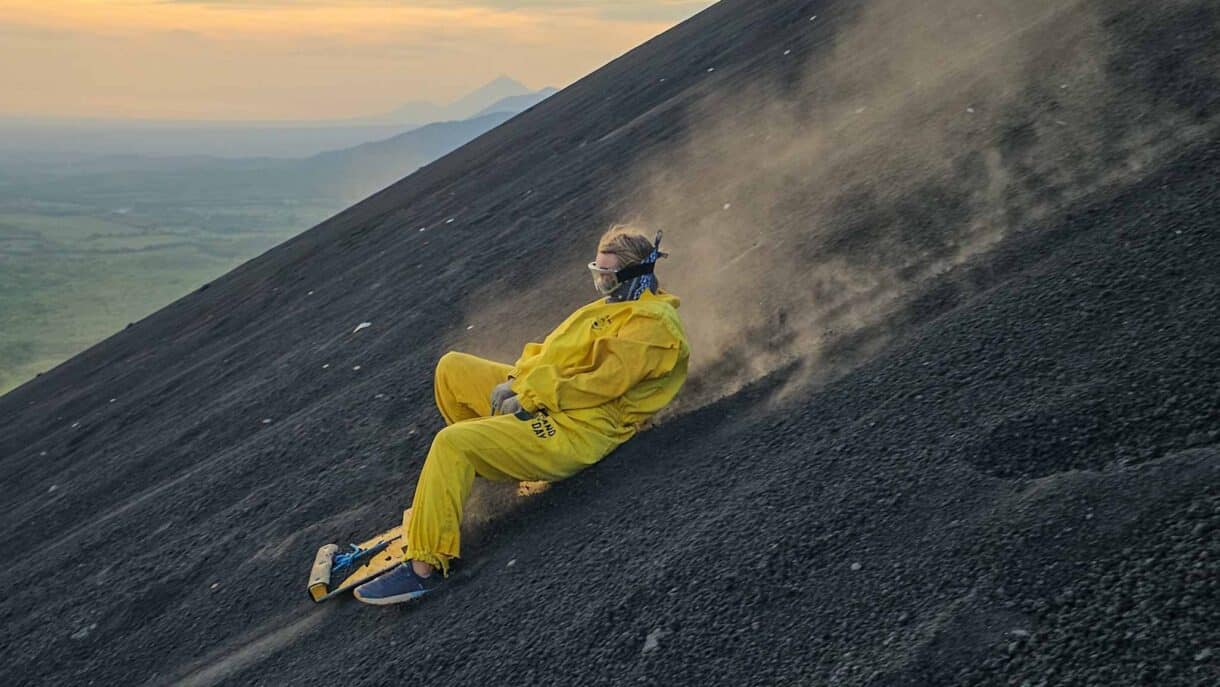
Volcano Boarding in Nicaragua: The ULTIMATE Guide [2023]
Volcano Boarding Nicaragua is an absolute must if you’re travelling to Central America. The pure, unadulterated joy of racing down an active volcano at speeds of up to 100km/hour, has stuck with me long after we returned home to Scotland. If you love unforgettable active adventures, volcano boarding Cerro Negro will be one of the most insane things you’ll do while backpacking in Nicaragua.
Here, we’re sharing our ultimate guide to Volcano Boarding in Nicaragua, including everything we WISH we’d known before doing this crazy activity.
This is the longest, most comprehensive guide out there. We’ve checked! It covers everything you could possibly need to know, and if you have any more questions, leave a comment and we’ll get back to you!
ABOUT VOLCANO BOARDING...
Cerro Negro is an active volcano near the vibrant, liberal city of Léon, Nicaragua. It’s the youngest volcano in Central America and is also one of the most active volcanoes in Nicaragua, erupting approximately every twenty years.
This baby volcano last erupted in 1999, so we’re well overdue an eruption soon. And what could be more exciting visiting a volcano that’s so close to exploding? Well, boarding down it of course!
Coming in second on CNN’s list of “50 of the most thrilling, daring things you can do on vacation” is volcano boarding down Cerro Negro in Nicaragua!
Well, that’s it. I was sold. There is no sport too extreme for me (that I’ve tried). We knew, even before visiting Nicaragua, that this was top of our list of things to do in the country.
Imagine the rush of sliding down an active volcano, feeling the wind in your hair and adrenaline pumping through your veins. In this ultimate guide, we will share everything we wish we’d know about volcano boarding to help you prepare for this crazy, unique experience.
Jump to:
- What is Volcano Boarding
- History of Volcano Boarding
- Where to go Volcano Boarding in Nicaragua?
- How many volcanoes can I board in Nicaragua?
- How much does Volcano Boarding in Nicaragua Cost?
- Do I need a tour company?
- Bigfoot Hostel VS Volcano Day: Who should I book with?
- What time of day should I go Volcano Boarding?
- What to pack & what to wear for volcano boarding
- How to get to Volcano Boarding in Nicaragua
- What to expect for Volcano Boarding
- Is Volcano Boarding Safe?
- Where else in the world can I go volcano boarding?
- Would we recommend volcano boarding?

At the crater of Cerro Negro
WHAT IS VOLCANO BOARDING?
Volcano boarding, often dubbed as the “craziest sport on Earth,” is exactly what it sounds like – riding down the slopes of an active volcano. Instead of waves, thrill-seekers surf down the ash-covered slopes of Nicaragua’s Cerro Negro on a specially designed wooden board, reaching speeds of up to 100km/hour (the fastest ever recorded speed was 172km/hour!).
The thrill of volcano boarding lies not only in the speed but also in its unique location. You’re literally riding down the slopes from an active volcano’s crater. If you dig a little hole into the gravel, you can burn your fingers from the heat! As you slide down, you’ll have breathtaking views of Nicaragua’s landscape and one of the best sunsets of your life.
But don’t freak out, the videos and photos you see online are a little misleading (including ours!). The slope looks really steep in photos, but once you start sledding, it’s not so bad. You only reach insane speeds if you actively try to break records, and you have the ability to control your speed at all times (I’ll explain how to do this later!).
HISTORY OF VOLCANO BOARDING
In 1999, a series of earthquakes in western Nicaragua set off the 730 metre tall Cerro Negro volcano, just outside the city of Léon. The youngest volcano in Central America gushed magma and spewed steam and ash for two days.
Fast-forward three years. In 2002, Eric Barone, a French cyclist, got the crazy idea to attempt a record-breaking bicycle run down Cerro Negro. He thought that the volcano’s smooth, ashy slopes would be perfect for this. But after reaching an impressive 172 km/hour (107 mph) on the slopes, Barone crashed, breaking both his bike and his ribs in the process.
This crazy guy was the inspiration for many, who began to try and invent new ways to enjoy the slopes of Cerro Negro. But he didn’t invent the sport…
WAIT, SO, WHO INVENTED VOLCANO BOARDING?
Barone may have tried speeding down the slopes of Cerro Negro first. But it’s adventurous Aussie, Darryn Webb, that truly saw the potential. The then-owner of Bigfoot Hostel in Léon, Darryn knew how to snowboard on sand dunes back home and began to experiment with this on Cerro Negro.
After some trial and error (including an actual snowboard, a mattress, a refrigerator, and even the hood of a car!) he finally discovered that a simple wooden sled with a thin piece of metal underneath would do the trick. Why this wasn’t his first idea, I’ll never know!
And thus, volcano boarding was born! Darryn Webb had succeeded and finally put Cerro Negro and volcano boarding on the travellers’ map. By 2004, Bigfoot Hostel were running the first ‘volcano boarding’ tours out of Léon, and other companies soon followed.
Now, volcano boarding in Nicaragua is one of the top attractions in Nicaragua and a staple of the Central America backpacking route. You will see tourists wearing volcano boarding tank tops from Panama to Mexico, and further afield! And you’ll nod or smile at each other in friendly comaraderie: you’ve both experienced something wild, exhilarating, and unforgettable.
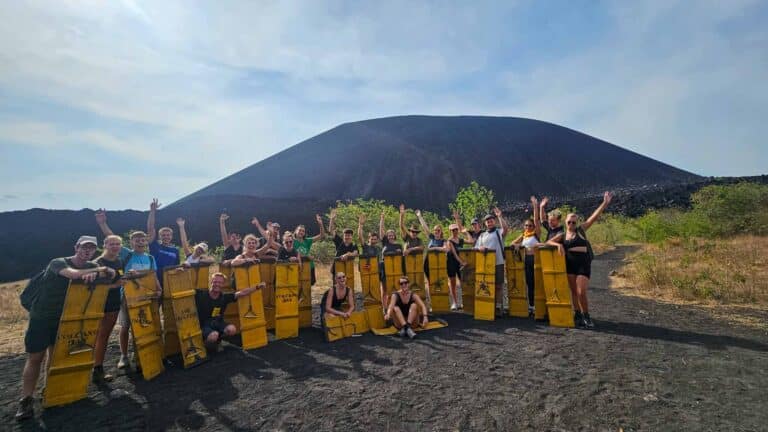
Full of energy for the hike up Cerro Negro (behind)
WHERE TO GO VOLCANO BOARDING IN NICARAGUA?
Léon’s Cerro Negro was the first place where you could try volcano boarding. It’s always exciting to try something where it was created.
Of the 19 active volcanoes in Nicaragua, Cerro Negro is unique. Not only does it have the perfect slope conditions, but it’s really easy to get to and it’s not too difficult to climb up and board down it. Léon’s Cerro Negro is the ‘home’ of volcano boarding and obviously the ultimate destination for this daring activity (and the one you’re probably considering if you’ve landed on this guide!).
It’s super easy to book a trip to Cerro Negro. There are several companies offering multiple volcano boarding trips per day and they’re all very similar in what they offer (more on how to choose a company later!).
It’s super easy to book a trip to Cerro Negro. There are several companies offering multiple volcano boarding trips per day and they’re all very similar in what they offer (more on how to choose a company later!).
HOW MANY VOLCANOES CAN I BOARD DOWN IN NICARAGUA?
Just one! But anyone who says that Cerro Negro is the only volcano in Central America that you can board down is wrong. If you haven’t had enough at Cerro Negro, you can fill your boots boarding down the active volcano, Pacaya, in Guatemala.
HOW MUCH DOES VOLCANO BOARDING IN NICARAGUA COST?
Most tours cost around $35 USD, but you can pay anywhere between $25 to $40 USD for volcano boarding in Nicaragua. Some companies offer a discount if you stay at their hostel, or a no-frills version where you pay a cheaper price and forego the souvenir t-shirt, dinner and alcoholic drinks.
This is definitely a fair price for the amount of fun you’ll have! Volcano Boarding is the top thing to do in Léon, and one of the top things to do in Nicaragua. It’s such a unique and awesome experience, and one of the highlights of our Central America trip!
It’s definitely an accessible price, even if you’re on a budget (like us!). Your trip will include all your transport, a guided hike, all the equipment, the boarding down, a full meal, and unlimited alcoholic drinks. We thought it was a bargain! But then again, most things in Nicaragua are. It’s a cheap place to have fun, and try new experiences.
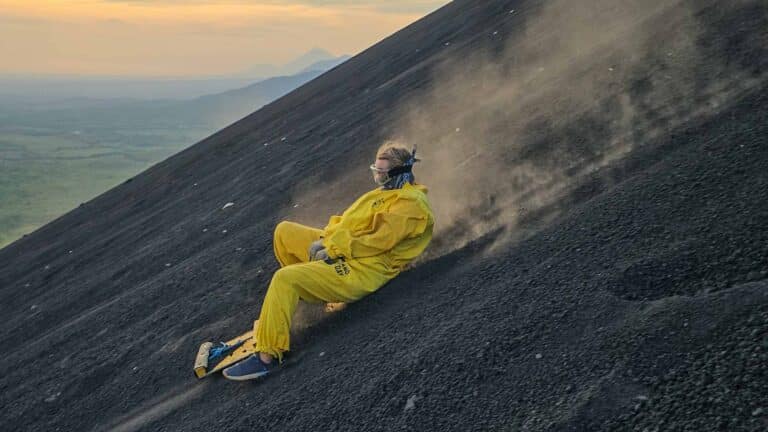
Boarding down Cerro Negro
DO I NEED A TOUR COMPANY TO GO VOLCANO BOARDING IN NICARAGUA?
Ooh, I just mentioned tours? You might be wondering if that’s essential, especially on a budget. So do you need a tour company to go volcano boarding in Nicaragua?
Ultimately, yes. Who else is going to provide that sexy jumpsuit and goggles combination? Not to mention the board (boarding isn’t much fun without one!) and the transport there and back? If you go alone, you’ll be missing out on the fab party afterwards too!
On a serious note, we do not recommend you try volcano boarding on your own. Your tour company prioritises safety, provides expert guidance, brings all your equipment, and has local knowledge about the volcanoes. They’ll make sure you have a great experience, take a million photos of you having fun, and you get to join in the social aspect (and party!) with other travellers, making friends that you’ll see up and down the rest of Central America.
SHOULD I BOOK WITH BIGFOOT HOSTEL OR VOLCANO DAY NICARAGUA TOURS?
Ah, the big question. We’ve written a whole guide for this, as we struggled to pick a company too! Ultimately, we chose Volcano Day because I liked their t-shirts better! But, having heard about other travellers’ experiences, we’re here to briefly weigh up the pros and cons to each of the volcano boarding companies in Léon.
Ok, let’s break it down.
When you arrive in Léon, you’ll notice two main players for volcano boarding tours on Cerro Negro. These are Bigfoot Hostel and Volcano Day.
Both tours include:
- Bilingual Tour Guide
- Transportation to and from Cerro Negro Volcano Nicaragua from Léon
- Safety Equipment (jumpsuit, goggles, gloves, board and bag)
- Fruit Snacks
- Unlimited rum and coke
- A free tank top or t-shirt
- The famous PARTY BUS back (sunset tours only)
- Lunch/Dinner
Both Cerro Negro Volcano Boarding tours cost $35 USD per person. Volcano Day is now running a ‘basic’ option at the cheaper price of $25 USD, but you don’t get a t-shirt or drinks/snacks and your meal included. Bigfoot Hostel will knock off $5 if you’re staying with them, making it just $30 USD!
Tour differences:
- Volcano Day Nicaragua is locally owned and operated. Their ‘thing’ is empowering local people (and volcanoes of course!)
- Volcano Day Nicaragua have smaller tour groups and tend to be more organised.
- Bigfoot Hostel organises an epic party back at the hostel each night, which you’ll be dropped off at right as it’s getting going.
The fact that Volcano Day are locally owned and the fact that they operated out of our hostel, were deciding options for us going with them, and we had no regrets.
Volcano Day Nicaragua also has way cooler tank top and t-shirt designs. They have their super distinctive ‘today is going to be a Volcano Day’ slogan on the back, which is so cute when you’re hiking other volcanoes around Central America! I wore mine every time we went up a volcano. They’re a bit less advertise-y too, which I liked. I hate walking around with company branding all over me!
Top tip: Anyone who says that only Bigfoot Hostel has the party bus on the way back is wrong! They are the biggest party hostel in Léon, but you get the party bus with both companies. Bigfoot Hostel does, however, have a party each night, which they’ll drop you off at. This isn’t open to just hostel guests though, so anyone can go!
WHAT ABOUT QUETZALTREKKERS?
Quetzaltrekkers is non-profit organization supporting local kids and their marketing is revolved around the fact they will let you slide the volcano twice. We didn’t hear about this company in Léon but actually discovered them afterwards and we love the concept.
They give you two runs down the volcano for the same price ($35 USD) as one with Bigfoot or Volcano Day, AND they put the proceeds toward helping street kids in Nicaragua. Quetzaltrekkers also has smaller groups. Seems like a no-brainer, right?
However, we really enjoyed that Bigfoot and Volcano Day make a real occasion of it. The actual boarding is a bit anticlimatic (more on that later) but the after party is really fun. Especially if you’re dancing on a bus with 15 or so new friends and you’re all a little tipsy! Afterwards, we all had dinner together, and some folk headed out to a bar and club later in the evening.
That said, if you aren’t a party person and are just in it for the boarding, we’d definitely recommend QuetzalTrekkers. We love the work that they’re doing to help kids across Nicaragua!

‘Today is gonna be a volcano day’
WHAT TIME OF DAY SHOULD I BOOK VOLCANO BOARDING IN NICARAGUA?
You’ll notice that the companies offer several different volcano tours at different price points and different times of day! Here are the key differences:
#1 VOLCANO BOARDING SUNRISE
Only Bigfoot Hostel and Volcano Day offer the chance to wake up at the crack of dawn and hike up Cerro Negro in time for sunrise. We’d had enough early mornings to take this offer, but it sounded romantic!
‘Volcano Boarding Sunrise’ generally includes:
- Leave between 3am and 4am
- Hike up Cerro Negro in the fresh morning breeze
- Explore the Volcano and enjoy the sunrise coming up behind neighbor volcanoes Telica and San Cristobal.
- Board down the volcano! (For an extra $5 USD, Volcano Day will let you go twice)
- Drinks & Snacks!
- Breakfast either with a local family, or back in Léon.
This tour does not include the party bus and, although alcoholic drinks are included, you might not want to start on the rum and cola at 9am (or maybe you do, no judgement from me!). However, it’s usually calmer with fewer people, which leads to a more intimate experience. You’re also back in Léon before 10am, so it’s great if you are short of time, have plans for the rest of the day, or want to continue on your travels.
#2 VOLCANO BOARDING DAY TOUR
All three companies offer a later morning departure. If you’d want to go at this time, we’d recommend Volcano Day! Their ‘budget option’ is just $25 USD or for an extra $10 USD they’ll take you to the beach for sunset and ply you with booze. For $30 USD, QuetzalTrekkers will let you board twice! Bigfoot’s day tour option is the same price as their other tours, and doesn’t really offer any special extras.
‘Volcano Boarding Day Tour’ generally includes:
- Leave between 8am and 9am
- Hike up Cerro Negro after sunrise. It’s still fresh and breezy though!
- Board down the volcano! (Hike and board again if you go with QuetzalTrekkers and have the energy!)
- Enjoy alcoholic drinks and snacks
- Lunch either with a local family, or back in Léon
- OPTIONAL add-on to head to the beach for sunset, just a 45 minute drive from Léon.
We recommend this tour if you don’t want to wake up too early, but still want to make the most of your day. It’s also a good option if you want to visit another volcano in the afternoon, or head to the beach for sunset, as both of these can be included at extra cost.
#3 VOLCANO BOARDING SUNSET
THIS is the one most people (including us) go for. You get an adrenaline rush sliding down Cerro Negro, before enjoying some drinks by the campfire as you watch the sun set. The sunset option also includes the famous party bus on the way back to Léon. They’ll turn up the music, turn down the lights, and everyone’s up and dancing in the seats/aisle. It’s really, really fun!
‘Volcano Boarding Sunset’ generally includes:
- Leave between 1pm and 2pm
- Hike up Cerro Negro during the day. It can be really hot, so don’t forget water!
- Board down the volcano!
- Toast marshmallows and enjoy a rum and cola (or several!) by the campfire as the sun sets behind the volcano
- Keep drinking and dancing on the bus back to Léon!
- Dinner either with a local family, or back in Léon
This was the option we went for and was one of the best things we did in Nicaragua, and during our entire Central America trip. I have such fond memories of this tour, especially the bus party. We’ve heard Bigfoot Hostel have an epic after-party at their hostel back in Léon too, so if you’re up for a big night out, we’d recommend checking out their options.
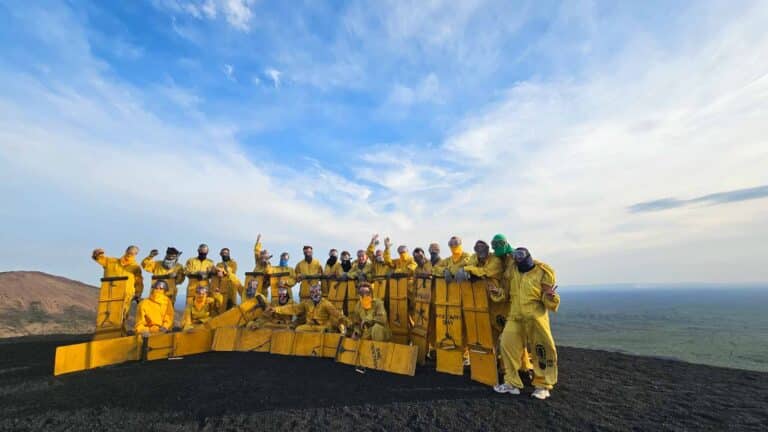
Our group is ready to board!
WHAT TO PACK FOR VOLCANO BOARDING:
The tour company will provide you with the essentials: a board, goggles, and that oh-so-sexy boilersuit that, at the same time, made me feel like I was extra in Breaking Bad, and also in Teletubbies. Here’s what else to pack to ensure you have a great time!
- Hiking boots / walking shoes good enough for a short hike.
- At least 1 litre water. More if you’re a thirsty person
- A sunhat, sunglasses, and sunscreen
- A Bandana/Scarf to tie around your nose and mouth (essential: stops you eating rocks for dinner). You can get them in the market in Léon really cheap. If you forget, you can buy one from your tour provider (~ $3 to $5 USD)
Top tip: Make sure you’re buying water to hydrate, not rum! In Nicaragua, both are clear liquids that come in one or two litre plastic bottles. And rum is so cheap that you might mistake it for expensive water. Our guide told us a story of a client who signed up for a two day hike. He’d brought four litres of rum instead of water, and hadn’t realised until halfway into the first day when it was too late!
WHAT TO WEAR FOR VOLCANO BOARDING
It depends what the weather is on the day, but generally it’s hot year-round in Léon. Between May and November is the wet season, and it can be pretty windy at the top of the Volcano. But it’s still warm. We wore our Volcano Day t-shirts and a pair of shorts, which were fine. The most important thing is that you wear something you’ll be comfortable in for a 45-minute uphill hike.
Every company will provide you with goggles, gloves, and a thick boilersuit so you won’t destroy your clothes. We also got given little drawstring backpacks to carry jumpsuits and water to the top of the volcano more easily – you’ll need your hands for your board! Remember to take at least one litre of water with you (extra if you drink a lot!).
Other than that, we recommend wearing good hiking boots or hiking trainers. They’ll help you on the way up, and when you board down the volcano you’ll need to break with your feet to control your speed.
If you’ve got long hair, it helps to tie it up (unless you want it in your face!). It’s also useful to bring some kind of bandana or an old t-shirt to cover up your mouth and nose when going down. In fact, most of the tour companies will insist on this!
We recommend not taking your phone or anything valuable. It’s super easy to lose it on the way down, and difficult to find it again! The guide will take photos of everyone and share them later on WhatsApp. Pretty much all the photos in this post were taken by our guide, who had a much better phone than me! Don’t worry, you can leave your valuables on the bus, and the driver will stay there to keep an eye on everything.
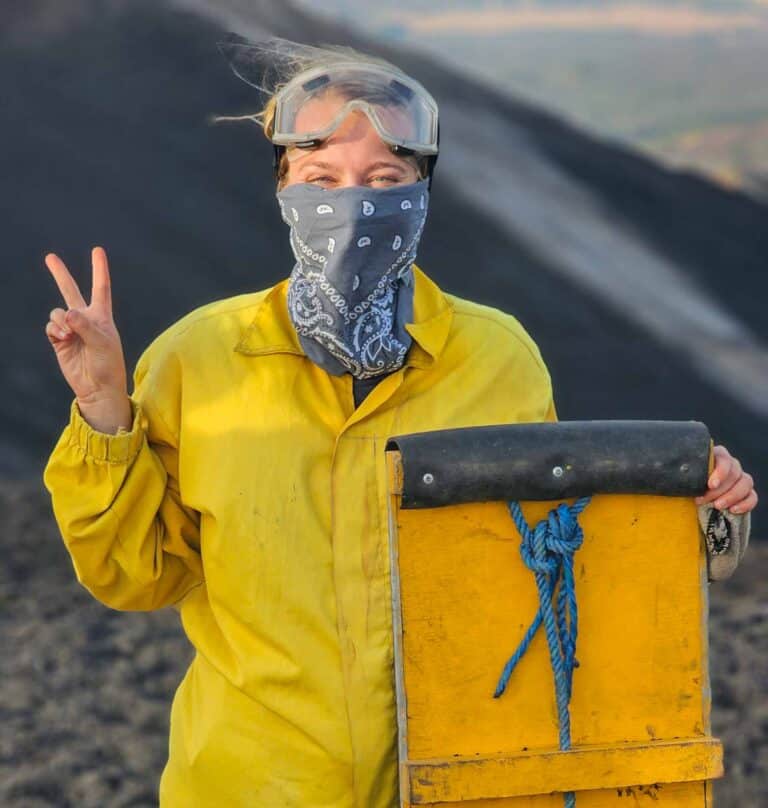
Boarding with Volcano Day
HOW TO GET TO VOLCANO BOARDING IN NICARAGUA?
#1 HOW TO GET TO LEON BY PUBLIC BUS
Total cost: $3 – 5 USD
FROM MANAGUA: You will need to get to the UCA bus station in Managua City and from there take the bus to Léon. Tickets will cost between 80 to 120 Cordobas ($2 – $3 USD).
FROM GRANADA: You will need to head to Granada Microbus station and take the bus to Managua’s UCA bus station. This journey shouldn’t cost you any more than 80 to 100 Cordobas ($2 – $2.5 USD). From Managua, you need to hop on the minibus to Léon. Tickets will cost roughly the same price again.
Top tip: It’s common to be charged ‘tourist tax’ for looking foreign, or a ‘bag charge’ for your backpack. Always check what the locals are paying, and unless your bag takes up a whole seat, be prepared to argue! For more tips on taking public transport in Central America, check out our ultimate guide to Central America’s crazy chicken buses.
#2 HOW TO GET TO LEON BY PRIVATE SHUTTLE
Total cost: $15 – 25 USD
FROM MANAGUA: Tourists tend to avoid Managua, so shuttle buses are less frequent, but you can get a shuttle bus from Managua to Léon for around $35. The shuttle takes approximately 2 hours, and you can either get picked up from the city or the airport. Check with your hostel or hotel for their recommendations and you might get a discount!
FROM GRANADA: Granada is a popular tourist destination and shuttle buses leave all the time! It’s a bit cheaper, due to the competition, and will set you back between $15 – 25 USD. The journey takes between 4-6 hours. Again, check with your hostel or tour operators in Granada for up-to-date times and prices.

The crater of Cerro Negro
WHAT TO EXPECT FOR VOLCANO BOARDING
#1 WHAT TO EXPECT: PREPARING FOR THE HIKE UP CERRO NEGRO
This is the easy part, just rock up and jump on the bus! Some people brought beers. Most people saved that for afterwards. You don’t want to be drunk or they won’t let you board, so take that into account!
The driver will be playing incredibly cheesy music. We were treated to some early 2000s – 2010’s English pop hits. So if this isn’t your jam, either mentally prepare yourself or bring some headphones!
#2 WHAT TO EXPECT: HIKING CERRO NEGRO
What goes up must come down, and vice versa! If you want to board down Cerro Negro, you need to hike up to the top first.
The hike takes about 45-minutes to reach the summit, and it’s not that difficult. You get to stop for a drink and a breather every 15-minutes. You can stay standing, or take a seat on your board, whilst your guide explains about the history and geography of the area.
The terrain can be a little difficult with the loose rocks – one step forward can feel like two steps back at some points! But everybody in our group made it to the top without any problems.
What can make the hike a little challenging is that you need to carry your own wooden board. It weighs about seven kilograms, so it’s not too heavy. But it’s awkwardly shaped and the wind can really push against it and knock you off your feet if you’re facing the wrong direction. Some of the guys in our group tried strapping it to their back, but were told to carry it in their hands unless they wanted to ‘take off like an airplane’.
A small group of local lads will walk up with the group. If you find yourself struggling they will offer to carry your board to the top for $3 to $5 USD. We decided to carry our own boards (got to stick to the budget!) but if you don’t want to, paying for a little help is a great way to support local people.
The hike itself is beautiful! The view from the top is great, you can see right down into the crater, which is sometimes steaming. You can also look across into the distance to see several of Nicaragua’s other volcanoes. They’re all in a line – the ring of fire – which is really interesting to see in real life.
If you want proof that this is an active volcano, dig a little into the gravel at the top. You’ll be able to feel the heat coming off the volcano and some people even bring marshmallows to cook over this heat!
#3 WHAT TO EXPECT: VOLCANO BOARDING
Now for the moment you’ve climbed all this way for, boarding down Cerro Negro!
The board is a simple, wooden, rectangular sled with a thin metal layer on the bottom. There’s a small place for your butt in the back of the board, and a rope in front for your hands. Sit down, pull the rope tightly towards you, and off you go! Your guide will give you a little push if you’re nervous.
If you get scared… don’t worry!
When you reach the top of Cerro Negro and look down the slope, it looks extremely steep. I was nervous. Lots of people in our team were too. Most people overcome this fear and decide to enjoy the ride down and I promise you, you don’t go half as fast as you’d expect. Getting to the bottom of Cerro Negro was honestly a bit anticlimatic. We shrugged at each other, as in ‘oh, that was it?’, then went to grab a drink and sit by the campfire.
However, no one will ever push you to do this activity. If you choose not to board, you can walk or run down the hill, or walk back the way you came.
HOW TO BOARD DOWN CERRO NEGRO
Once everyone is ready to gear up, your tour guide will give you a detailed instruction on how to get down the volcano safely.
There are no breaks! But don’t panic. Once you’re going, you can control your speed with your feet. The safest way to go down is to sit, hold the rope, keep your feet flat on the ground. In this position, the board won’t move faster than you want it to, and you can dig your feet into the gravel to slow yourself down. If you feel comfortable and want to speed up a little, lean your body back and pull the rope really tightly, whilst still keeping your feet on the ground.
To go even faster, lean back and pull the rope tight whilst you lift your feet off the ground. To slow down or break, dig your feet into the gravel. It’s really easy, and you’re in total control of your speed at all times.
YOU CAN BOARD OR SNOWBOARD DOWN BUT…
…standing on the board might look cool on Instagram, but in reality, it’s pretty lame as it slows you down. It is much more fun to sit on the board like on a sledge. It’s safer, you’re in better control of your speed, and you can go faster if you want! Save the standing up for those surfing lessons in San Juan del Sur!
Top tip: I was a little nervous, but I actually regretted going so slow at the beginning because it meant I couldn’t gain speed as I got more confident. My advice would be to go 100%. If you get too scared, you can always slow yourself down, or worst worst case, you can roll off the board.
#4 WHAT TO EXPECT: THE AFTER PARTY
Ahh the after party! If you’ve chosen the sunset tour, you’re in for a treat.
After boarding down the volcano, strip off your boilersuit and head down to the campfire to relax and enjoy the sunset. Once everyone’s down, your guides will hand out snacks (apples and marshmallows to toast!) and crack open the beer cooler!
This is where it gets a bit crazy. Most evening tours include unlimited rum and coke. And in Nicaragua, they aren’t shy with the rum! Once it gets dark, everyone will jump back onto the bus to head back to Léon. The driver will turn off the main lights and switch on these amazingly tacky LED lights. The music is on, the drinks keep coming, and everyone is up and dancing all the way back to Léon! And when you’re back, you get tacos!
If you’re on a sunrise tour or day tour, your experience will be a little bit different. Some tours take you straight back to Léon and some will drive you to the beach, where you get to have a similar party whilst the sun goes down. Scroll up a little to read about the different tours and figure out which is right for you.

The hike up (and my concentration face)
IS VOLCANO BOARDING SAFE?
Don’t worry. While the activity sounds insane, if you follow all the instructions, volcano boarding in Nicaragua is actually really safe.
There have been no volcano boarding deaths and very few volcano boarding accidents. You can control your speed at all times, and although it looks steep, it’s really easy to stop yourself if you’re uncomfortable. This means accidents – usually just minor injuries – only occur when people are trying to go as fast as possible. The only injury on our trip was me, and that’s because I tripped on the hike up and grazed my knee (and I’m really clumsy so you’ll probably be fine)!
The guides will kit you up with gloves, a boilersuit, and some super sexy ‘lab goggles’. They’ll teach you how to control the board and you always have control of your speed. I was cautious at first but tried to speed up, and the ‘speed gun’ eventually clocked me at around 43km/hour. It was actually hard to make the board go very fast, I’d have loved to be a bit speedier. If I ever go back I’m launching myself down that hill with reckless abandon!
It is important to keep in mind that, Cerro Negro volcano is obviously a volcano. Although the volcano is carefully monitored, eruptions have happened in the past. The last time Cerro Negro erupted was 1999, and with eruptions every ~20 years, we’re overdue! Hiking an active volcano will never be a completely safe activity, so always listen to your guides, and never set off on any adventures without adequate travel insurance.
WHERE ELSE IN THE WORLD CAN I GO VOLCANO BOARDING?
Only volcanoes where a recent eruption has generated the ashy slopes suitable for this activity. This means there are a just handful of locations in the world where you can experience volcano boarding. Pretty special, huh?
Here are all the places in the world you can go Volcano Boarding:
1.
Léon, Nicaragua: As we’ve mentioned, Léon in Nicaragua is the birthplace of volcano boarding. Cerro Negro’s ash-covered slopes are perfect for it!
2.
Pacaya, Guatemala: If you’ve got a taste for volcano boarding, here’s another one in the Central America area! Most people hike around the Pacaya Complex, but there are some tour operators offering the rare chance to surf down the slopes.
3.
Mount Yasur, Vanuatu: Vanuatu, an island nation in the South Pacific Ocean, is home to Mount Yasur. It’s not as widely known for volcano boarding as Nicaragua, but the volcano’s accessibility and regular eruptions make it a perfect destination! It’s a little more dangerous though, eruptions can occur daily.
4.
Mount Bromo, Indonesia: Mount Bromo is an iconic volcano and a more recent addition to global volcanoboarding destinations, with its latest eruption dating 2015.
5.
Mount Etna, Italy: Mount Etna, is one of the most active volcanoes in Europe. Although we couldn’t find any guided tours, you can certainly see people boarding and skiing by themselves. Unless you’re a pro, we don’t recommend this.
WOULD WE RECOMMEND VOLCANO BOARDING IN NICARAGUA?
Definitely! Volcano Boarding in Nicaragua was one of the best things we did in Central America. Even though it sounds way more adrenaline-packed than it actually is, not many people can say that they’ve ever boarded down a volcano. There are only a few places in the world you can do this, so it’s not one to be missed!
It’s difficult to hike up volcanic scree with a huge board, but the climb itself is worth the trip just for the views over the other volcanoes. The after party is also really awesome, in fact, we found it more fun than some huge organised parties, such as Granada’s Treehouse Rave. And we thought that the price is super accessible for most tourists, especially since it includes all your snacks and dinner! We loved this trip, and it’s definitely not one to miss whilst you’re in Central America.
We hope we’ve covered everything. If you have any more questions, shoot us a message on Instagram or leave us a comment! We’re pretty active here, and we’ll get back to you soon.
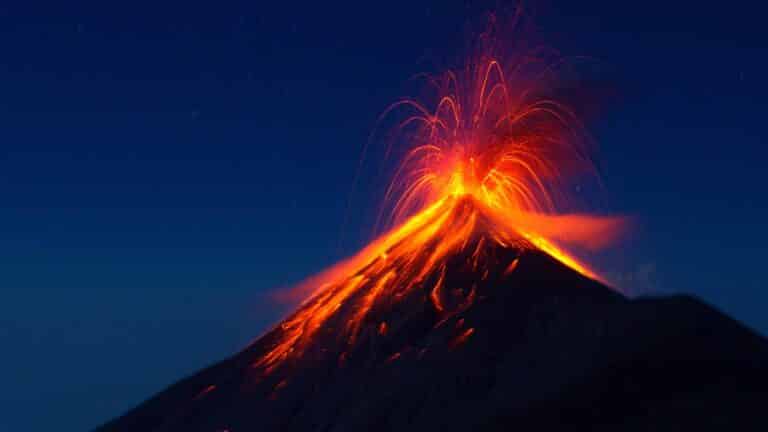
Into volcanoes? Head to Guatemala and check out Acateango! (above)
FAQs
IS VOLCANO BOARDING DANGEROUS?
All sports are dangerous and you will be sledging down an active volcano! But if you go with a reputable tour company, follow instructions, and wear safety gear, you’ll be unlikely to get more than just a few bumps and grazes.
IS VOLCANO BOARDING WORTH IT?
Yes! Volcano boarding is absolutely worth it – we had the best time. The rush of sliding down an active volcano’s slopes is an unforgettable adventure and you’ll create lasting memories of your time in Nicaragua and Central America.
WHERE CAN YOU GO VOLCANO BOARDING?
You can board down a volcano in just a few places in the world! These are: Cerro Negro, Nicaragua; Pacaya, Guatemala; Mount Yasur, Vanatu; and Mount Bromo, Indonesia. Theoretically, you can also board down Mount Etna in Italy too, but we couldn’t find any tours for this and we don’t advise trying it alone.
WHAT ARE THE RULES OF VOLCANO BOARDING?
Basically, just listen to your guide. Wear the safety gear they give you, listen when they teach you how to control the board, and don’t do drugs/alcohol before you go (save it for after!).
WHO INVENTED VOLCANO BOARDING?
Adventurous Aussie, Darryn Webb, knew how to snowboard on sand dunes back home and began to experiment with this on Cerro Negro. After trying a mattress, a fridge, and even a car hood, he settled on the sledge we use today!
LIKE IT? PIN IT!
SAVE THIS POST TO PINTEREST TO INSPIRE YOUR NEXT ADVENTURE!
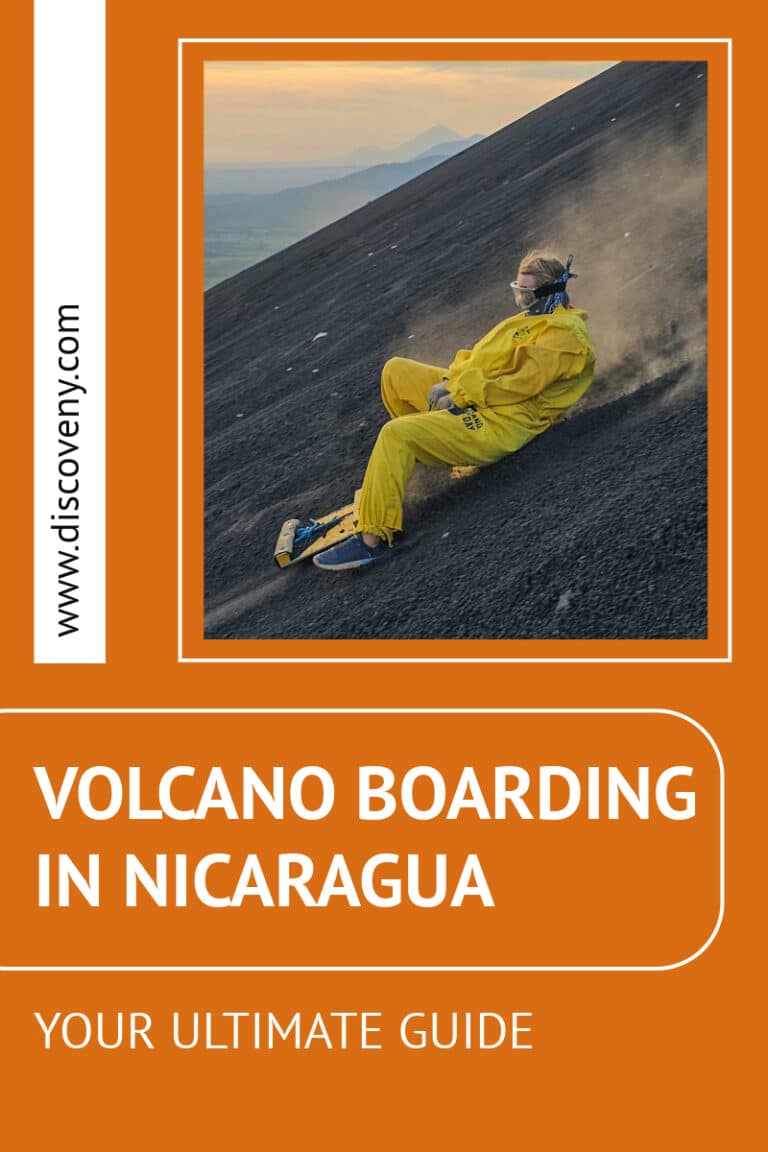

Follow our daily adventures on Facebook and Instagram
Disclaimer: The information and advice provided in this blog are the author’s opinions and based on their personal experiences. All information was accurate at the time of writing. However, things can change quickly, so always double-check current conditions and guidelines before setting out. Remember, your travels and safety are your own responsibility, and this blog can not be held responsible for anything that might happen on your adventures! Always exercise caution and good judgment. Oh, and don’t forget to get travel insurance! Happy travels!
This post may contain affiliate links (yay for transparency!) This means that I will earn a small commission, at no additional cost to you, if you click the link and choose to buy the product. I only link to stuff I have personally bought and found useful and never endorse crap. Your support helps keep the site going, thank you!
Alice
Alice is a UK travel blogger who advocates sustainable travel and being more eco-conscious on a budget. She loves coffee, her houseplants and summiting mountains.
You May Also Like
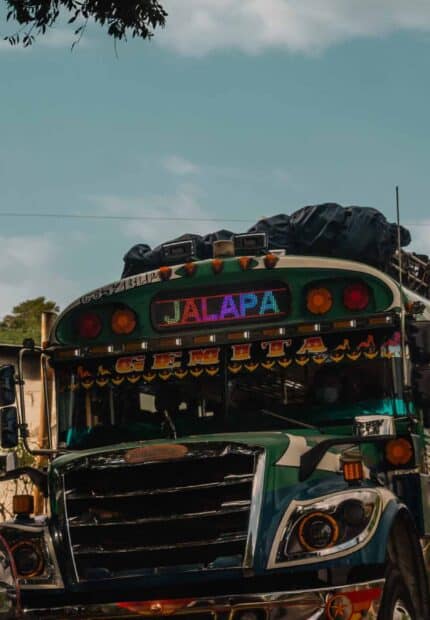
Chicken Buses in Central America: The Ultimate Guide
October 1, 2023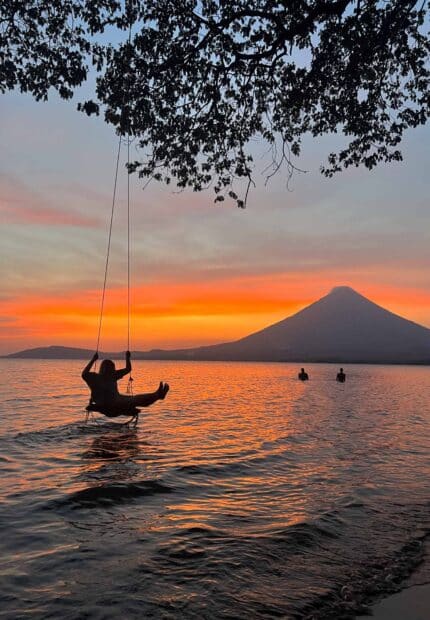
Do I Need to Speak Spanish to Travel in Central America?
April 13, 2024